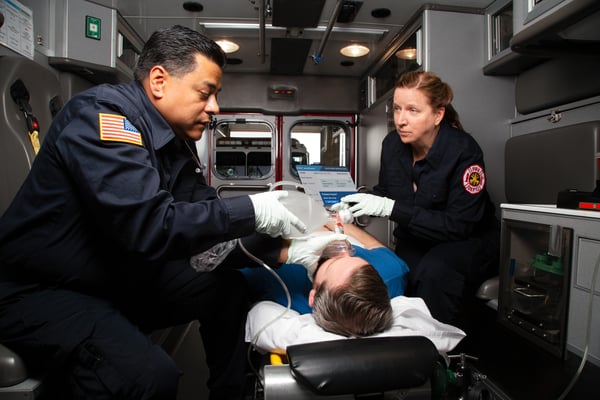News Alert: New ePCR Integration Simplifies EMS Data Management and Enables Better Care Coordination
Interoperability Has Come a Long Way, but There Is Much to Be Done
(8 min read) 2020 has been an interesting year, and at the time of this writing, it’s only September
Was this information valuable?

(8 min read) 2020 has been an interesting year, and at the time of this writing, it’s only September. I am sure the word of the year will actually be a phrase: “social distancing”.
Six months into COVID-19, opinions on “would have/could have/should have” are rampant. You name it, every decision large and small is up for discussion. Perhaps that’s as it should be, so long as the critique is well-intentioned and grounded in a fact-based framework with the goal of improvement. Bearing that in mind, let’s do a pulse check on the status of pre-hospital interoperability, transparency, and health information exchange as they pertain to care during the pandemic. It’s worthwhile to consider what we have in place today, what might have been, and what we need to improve to reap bigger benefits during the next phase.
Current State of Pre-Hospital/Hospital Interoperability
 First, a quick rundown on the status of interoperability from the pre-hospital perspective. While the Office of the National Coordinator for Health IT (ONC) has been funded, empowered, and engaged in assisting hospitals and physicians in the implementation of electronic health records (EHR) and health information exchange (HIE), they haven’t leveled the playing field for EMS providers.
First, a quick rundown on the status of interoperability from the pre-hospital perspective. While the Office of the National Coordinator for Health IT (ONC) has been funded, empowered, and engaged in assisting hospitals and physicians in the implementation of electronic health records (EHR) and health information exchange (HIE), they haven’t leveled the playing field for EMS providers.
Although ONC has worked to support interoperability for EMS and pre-hospital care, no funding has been provided; therefore, reimbursement for HIE services and interoperability is not possible. Without funding, success has only been achieved in situations where hospitals and/or healthcare systems have stepped in to provide (or fund) a health information exchange solution to benefit all participants, including pre-hospital providers.
Despite this lack of funding and resources, there has been progress in the pre-hospital sector from a standards, information technology (IT), and implementation perspective. For example, ZOLL® Care Exchange is a secure, standards-based, bi-directional exchange solution currently in use by EMS and hospitals/healthcare systems.
With all bi-directional health information exchange solutions, there are still challenges. Even national healthcare exchanges, such as CommonWell Health Alliance and Carequality, have produced lackluster results when it comes to the vision for a single connection that enables EMS agencies to exchange timely, meaningful information with every hospital and healthcare system in their service area. The ability to match patients treated by EMS and other healthcare providers, ensure timely updates, assure quality input, and make up-to-date information available at the time of care is inconsistent. This variability requires each hospital system to connect one-to-one with each EMS agency, as opposed to allowing automated updates to patient records by any provider that is a member of the exchange. This siloed approach negates many of the intended efficiencies and benefits of HIE. It is very time-consuming and frequently limits success.
Missed Opportunities to Improve Coordination and Patient Outcomes
With the current state of HIE as a backdrop, let’s consider how a broad-based, fully functional implementation could have improved coordination of resources and patient care during the first six months of the COVID-19 pandemic.
If the pre-hospital care industry had fully implemented HIE prior to the pandemic, how would care delivery, public health, and outcomes have been affected?
There is no doubt that a fully functional, bi-directional health information exchange spanning all of healthcare, EMS included, could have a significant positive impact on managing any public health crisis, including this pandemic. The timely sharing of information benefits patients and EMS professionals alike. Rapid access to information about which patients tested positive for COVID-19 enables the EMS crew to quickly assess their exposure and act, if needed. It also provides data in near-real time about clustering of cases within the EMS service area — critical information that can assist with contact tracing. This, in turn, lessens the potential for uncontrolled outbreaks and helps health providers, public health agencies, and local governments cooperate to “flatten the curve” and hasten a return to more normalcy in their communities.
From a healthcare system or hospital’s perspective, understanding the EMS volume, case clustering, and receiving patients’ medical information prior to transfer to their facility combine to support better triage in the emergency department and beyond. Timely data sharing also supports better patient management and resource planning at a time when facilities are crowded and resource-constrained, due to the pandemic.

Emergence of Remote and Treat-in-Place Care as Preferred Options
How would a fully implemented HIE have improved the quality and efficacy of treatment in place, ET3, telehealth, and telemedicine options within the system of care?
We have all witnessed the wave of changes and innovations driven by COVID-19. Whether we are sequestered at home and working remotely, postponing travel plans, or managing home schooling, etc. — life is much more complicated than it was before, and it will not likely return entirely to the old normal. For example, many businesses, including ZOLL, are exploring how to make remote workplace options for a portion of the workforce permanent, where possible.
The healthcare industry is investing heavily in telehealth/telemedicine capabilities. In some physicians’ office practices where community spread is not well-controlled, face-to-face visits are not an option; they have shifted completely to a remote approach. Most healthcare insurance plans now cover telehealth consults. Beyond the pandemic, the accelerated availability and viability of telemedicine has many applications, especially as the technology improves. The same is true for treat-in-place and community paramedicine services. Consider the significant benefits for patients with limited mobility, lack of transportation options, or who live in rural areas where specialized care may be hours away. These relatively new avenues of care provide access to quality care, convenience, and promote wellness by removing barriers for many within the community.
Unfortunately, during this time, where COVID-19 is a constant threat, EMS can’t completely avoid face-to-face interactions. There are, however, ways to limit or control them in the interest of safety. The Emergency Triage, Treat, and Transport pilot program (ET3) sponsored by the Centers for Medicare and Medicaid Services (CMS) provides a mechanism for EMS to provide billable care without transportation or by transportation to a non-emergency healthcare facility destination. With ET3, there is still an EMS response and an evaluation by a clinician via a telehealth/telemedicine consult. This approach can limit the extent and duration of the EMS crew’s potential exposure to the disease and mitigate risk to both the medic and to the next patients they treat.
Expanding and Improving Interoperability for Public Health Crises
How can we better leverage interoperability technology and policy to prepare for and implement improvements in advance of the next public health crisis?
This last topic is the toughest to tackle (no pun intended, but I will miss college football…). There is widespread agreement that the COVID-19 pandemic will last a minimum of another six months (pending vaccine availability). It is difficult to tackle a healthcare issue that is so large and complex that it impacts our patients, healthcare system, and economy. This is truly a once-in-a-century event. It is always my hope that we can learn from history as opposed to repeating it. Interoperability and HIE, fully implemented, would have been a great tool in our tool belt when the first cases were diagnosed.

The implementation of interoperable systems requires cooperation, collaboration, and a calm but deliberant perspective (notice I was going for 3 Cs). As COVID-19 plays out over the next six months, or until we have a vaccine, gains toward fully implementing HIE will be limited.
But, just as the federal government funded multiple programs post-9/11 to address potential risks from a future physical or biological event, we have before us an opportunity to invest in interoperability to assist in the next public health crisis.
For healthcare to be fully integrated from an interoperability perspective, we need to leverage and consolidate resources. It is not just about sharing health information to ensure that each patient receives the appropriate and timely treatment. The goal is to integrate the entire healthcare system to improve efficiency and control costs. As we see an increased level of mergers and acquisitions addressing these issues, EMS must be bold and demand to join hospitals and health systems at the table. If we aim to manage the telehealth movement better, or for that matter, the next pandemic, the heightened coordination between hospitals, healthcare systems, and EMS is an absolute priority.
Sadly, at this time, the only avenue for funding this type of a system of care is through hospitals, leveraging their mission to address population health and provide value-based care. There likely will be some federal and state funds allocated to building (or rebuilding) device and pharmaceutical stockpiles, as well as to providing training resources. As much as it should be a priority, interoperability is not likely to be viewed with the same sense of urgency. As these emergency stockpiles and public health plans move forward over the next few years, the perfect opportunity will emerge for EMS to flex its muscles and stress its expertise, vision, and capability to advance full interoperability within our healthcare system.
In closing, William Edwards Deming was one of the thought leaders in the performance improvement and quality management movement. I have always remembered this famous quote attributed to him: “In God we trust; all others must bring data.”
Please don’t hesitate to comment or communicate with me at gmears@zoll.com regarding this or any other EMS data topic.
Read more about health information exchange (HIE):
Five EMS Technology Improvements that Will Shape the Next Ten Years
Related Posts
4 Must-have Data Points for Dispatch-Billing Alignment and Maximum Reimbursement
How STAT MedEvac Connected Device, Software, and Data Technology To Enhance QA and Elevate Care
ZOLL Pulse Blog
Subscribe to our blog and receive quality content that makes your job as an EMS & fire, hospital, or AR professional easier.
ZOLL Pulse Blog
Subscribe to our blog and receive quality content that makes your job as an EMS, fire, hospital, or AR professional easier.




